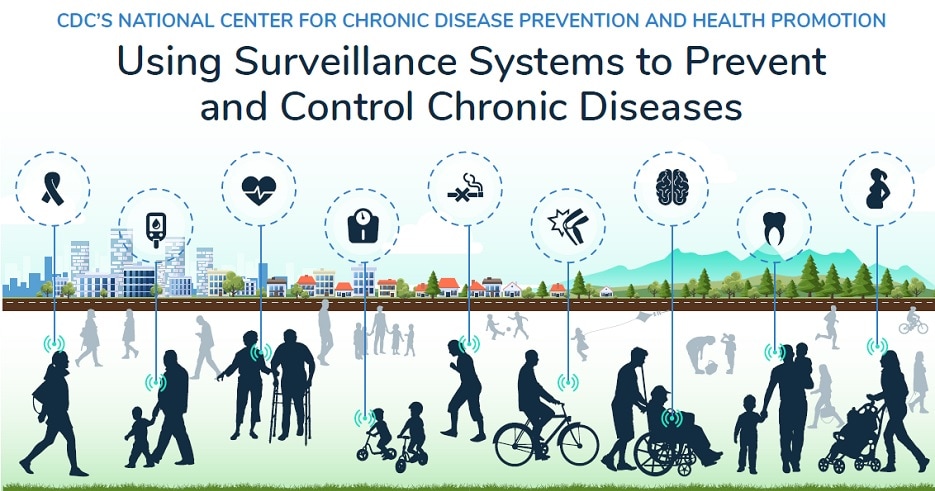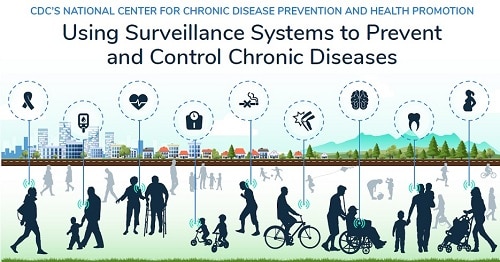Using Surveillance Systems to Prevent and Control Chronic Diseases
CDC surveillance systems collect data on chronic diseases and their risk factors. These systems—often the only source of such data—are vital for understanding how chronic diseases affect people in the United States. Without them, our prevention and control efforts would be guesswork. Surveillance data guide us in putting our resources to the best use.
Cancer
To help understand and prevent cancer in Americans, CDC’s National Program of Cancer Registries (NPCR) supports the collection of information on all new cancer cases and deaths and produces US Cancer Statistics annually. These data inform activities to promote cancer-healthy communities, catch cancer early, increase survival, and achieve health equity.
NPCR and US Cancer Statistics data highlight:
Every year there are over 1.7 million cancer diagnoses and nearly 600,000 cancer deaths. These numbers help track our progress, like fewer young women getting cervical cancer since the HPV vaccine became available. Cancer data also show which communities can benefit from awareness, cancer prevention and improvements in care. For example, American Indian and Alaska Native people have much higher rates of lung, colorectal, liver, stomach, and kidney cancers, compared to non-Hispanic White people in the United States.

Diabetes
Diabetes is the seventh leading cause of death in the United States. Data from the United States Diabetes Surveillance System (USDSS) and the National Diabetes Statistics Report help us understand the impact of diabetes, prediabetes, and diabetes complications in the United States.
USDSS and Statistics Report data highlight:
More than 34 million people in the United States (10.5%) have diabetes, and 88 million US adults (more than 1 in 3) have prediabetes, which increases their risk for type 2 diabetes. Participation in the CDC-led National Diabetes Prevention Program can prevent or delay type 2 diabetes in adults at high-risk. CDC also works to increase access to diabetes self-management education and support services, which help people learn how to manage diabetes and prevent complications.

Heart Disease and Stroke
To prevent disability and death from two of the nation’s biggest killers, we focus on risk factors like high blood pressure. Data from the National Health and Nutrition Examination Survey (NHANES) tell us how many people have high blood pressure and if their condition is under control.
NHANES data highlight:
About 75 million American adults have high blood pressure, and almost half (46%) do not have their blood pressure under control. About 1 in 5 are not even aware they have high blood pressure. These numbers have led to successful work with health systems to find and effectively treat more people with high blood pressure.

Obesity
To help children and teens stay at the right weight so they can avoid chronic diseases like heart disease, diabetes, and cancer later in life, we use data from the National Health and Nutrition Examination Survey (NHANES), which measures overweight and obesity, what kids eat and drink, and how much time is spent watching television, watching videos, or playing video games.
NHANES data highlight:
More than a third (35%) of children have overweight or obesity. This information is vital for understanding the current and future severity of our national overweight and obesity problem and the importance of programs in childcare settings, schools, and communities that reduce screen time and improve physical activity and nutrition.

Tobacco Use
We know that one of the best ways to lower smoking rates nationwide is to prevent youths from ever starting to smoke. The National Youth Tobacco Survey (NYTS) measures the use of all tobacco products, including e-cigarettes, by students in grades 6 through 12.
NYTS data highlight:
Current tobacco product use declined among US middle and high school students from 2019 to 2020. Yet, nearly 4.5 million students in 2020 were current tobacco product users. Continued tobacco control efforts at the national, state, and local level, like increasing the price of tobacco and requiring smoke-free public spaces, are warranted to sustain this progress and prevent and reduce tobacco product use among US youths.

Arthritis
Arthritis is one of our nation’s leading causes of work disability. We measure how many US adults have arthritis and how many are limited by it with the National Health Interview Survey (NHIS).
NHIS data highlight:
More than 54 million US adults have arthritis. About 24 million adults are limited in their activities from arthritis, and nearly 15 million adults with arthritis report severe joint pain. These findings show that people with arthritis urgently need to know that there are steps they can take to keep their symptoms under control, like being active, taking part in self-management education and physical activity programs, and staying at a healthy weight.

Alzheimer’s and Other Dementias
We do not know how to prevent Alzheimer’s disease yet, but we can help people get diagnosed early and remain independent for as long as possible. The Behavioral Risk Factor Surveillance System (BRFSS) asks adults aged 45 and older if they have noticed increased confusion or memory loss, also known as subjective cognitive decline, during the past 12 months.
BRFSS data highlight:
Data from 51 states and territories show that 1 in 9 Americans aged 45 and older report subjective cognitive decline. States use this information to develop state plans, increase awareness about the needs of older Americans, and guide elder justice and emergency preparedness efforts for older adults.

Tooth Decay
Cavities are one of the most common chronic diseases of childhood. We know that pain from cavities (tooth decay) can cause children to have problems eating, speaking, and learning. Children with poor oral health miss more school and receive lower grades than children who don’t. Dental sealants prevent 80% of cavities over 2 years in the back teeth, where 9 in 10 cavities occur. The National Health and Nutrition Examination Survey (NHANES) measures how many children aged 6 to 11 have cavities and dental sealants.
NHANES data highlight:
Only 4 in 10 children get dental sealants. Children from low-income households are 15% less likely to have them and twice as likely to have untreated cavities as children from higher-income households. School sealant programs are especially important for reaching children who are at greater risk for developing cavities and less likely to receive private dental care.

Maternal Deaths
About 700 women die of pregnancy-related causes each year in the United States. We need a systematic way of collecting data about these deaths to better understand the risk factors. The Pregnancy Mortality Surveillance System (PMSS) monitors pregnancy-related deaths and their causes.
PMSS data highlight:
The rate of pregnancy-related deaths is more than 3 times higher for Black women than White women. Cardiovascular disease, infections, and hemorrhage are leading causes of pregnancy-related deaths. By better understanding what causes pregnancy-related deaths and how to prevent them, we can save lives.


